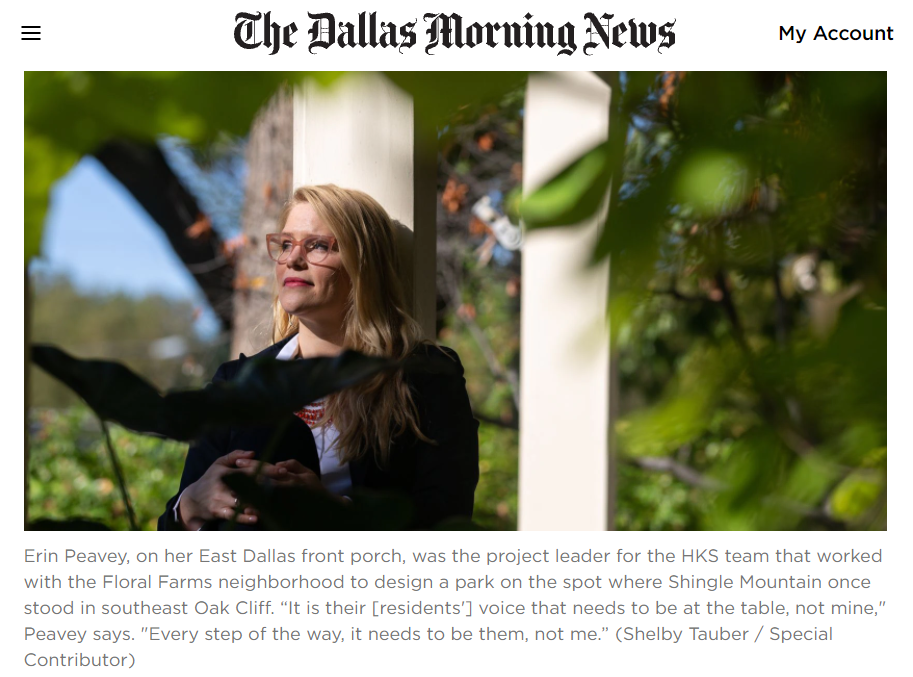Featured News
-

National Geographic - How to design a city to improve your mental health - according to science
Discover how innovative urban design can boost mental well-being in cities. This featured article explores science-backed strategies for creating environments that support emotional health, from integrating nature to fostering social connection, and highlights the challenges and opportunities in building healthier urban spaces.
-

Psychology Today - How to Design for Solitude
Find calm in a busy world. This featured article by Erin Peavey explores how thoughtful design can create spaces for true solitude-whether at home, in nature, or at work. Discover practical strategies and inspiring examples that show how architecture can nurture reflection, creativity, and well-being for everyone seeking a restorative pause from daily life.
-

Erin Peavey Honored as 2024 AIA Young Architect
Erin Peavey, AIA, has been honored with the 2024 AIA Young Architects Award, recognizing her national leadership in advancing design for health, well-being, and social connection. As an architect, author, and advocate, Erin bridges research and practice to create environments that help people thrive-from hospitals and schools to city neighborhoods. Her innovative work, mentorship, and public outreach are inspiring a new generation to see architecture as a catalyst for healing and community.
John Oliver Features Project
John Oliver discusses environmental racism, how both government and industry are failing people of color, and pandas. Featuring the Floral Farms community, where Shingle Mountain once stood 6 stories high.
How will the Floral Farms neighborhood heal after Shingle Mountain?
"Poisoned by Zip Code, Mended by Design" featured (from left) Miguel Perez, KERA arts reporter; Ari Brielle, artist; Marsha Jackson, activist and Floral Farms resident; Erin Peavey, architect, HKS and Evelyn Mayo, chair of Downwinders at Risk. Here on stage at the Dallas Museum of Art
Rethinking The Future Award
The story of the Floral Farms Park is one of reclamation, connection, and healing. It’s not just about the removing an illegal dumping site, where a mountain of shingles grew to be six-stories tall— it’s about reclaiming the identity of a vibrant neighborhood that came to be known as “where Shingle Mountain is”.
Dallas Morning News: ‘A place of community and healing’
‘A place of community and healing’: This Dallas architect led park design for Shingle Mountain site .
‘Together we can move mountains’ is the motto of the park — and of Erin Peavey’s effort to ensure that the Floral Farms neighborhood got the proposal it envisioned.
Connect + Cities: Foundation for Social Connection and Social Health Labs
Join us for the third event in the Connect+Conversations series! This session will focus on how the places where we live, work, and play influence our social relationships.
We will explore the latest research, recommendations, and real-world examples of designing the built environment and neighborhoods to reduce loneliness and strengthen communities.
You will hear from experts in this space and have the opportunity to engage with people across the US and globally. Join the conversation if you are interested in learning and discussing:
What features of the built environment contribute to social health
How urban vs. rural communities help or hinder social connection
Why design and programming must go hand-in-hand
And more!
Visible Voices Podcast
I was honored to be in conversation with Jennifer Roberts, PhD and Resa Lewiss, MD on her podcast, Visible Voices talking about the role of the built environment on health.
Psychology Today: Designing for Happiness
Loneliness and social isolation are threatening millions of people; however, increasing connection can reduce risk.
The places we live can exacerbate our sense of isolation and loneliness.
Concrete design strategies—like universal accessibility, incorporation of nature, and shared spaces—can foster social health.
World Happiness Week: Designing for Urban Connection
Partnering with Social Health Lab’s founder, Kasley Killam, MPH from Harvard University, to discuss Designing for Urban Connection as a part of the World Happiness Week events, hosted by Togetherness Hub!
Pandemic-Resilient Healthcare Design
HKS Health and Arup have partnered to share The Pandemic-Resilient Hospital: How Design Can Help Facilities Stay Operational and Safe. In this webinar, we explored detailed architectural, MEP engineering and medical planning strategies to create and adapt facilities to be more resilient to long-range airborne diseases, such as SARS-CoV-2.










